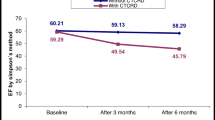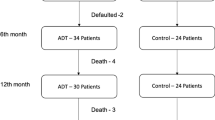Abstract
Background
Androgen-deprivation therapy (ADT) is a treatment option for locally advanced and metastatic prostate cancer (PCA). The aim of the study was to evaluate the effect of ADT on left ventricular (LV) functions assessed by speckle-tracking echocardiography (STE) in prostate cancer (PCA) patients.
Methods
Forty-nine consecutive PCA patients (mean age 71.5 ± 6.7 years) who would be treated with radiotherapy and ADT and 32 consecutive PCA patients (mean age 71.9 ± 7.0 years) who would be treated with radical or partial prostatectomy and 42 age-matched healthy men (mean age 70.5 ± 9.1 years) were included in our study. The left ventricular functions were assessed by both conventional echocardiography and STE at baseline and 6 months later.
Results
There were not any significant difference in characteristics of the patients and controls. There were not any significant differences in conventional echocardiographic measures at baseline and at 6th month among the PCA patients and controls. Although there were not any significant differences in STE measures at baseline among the PCA patients and controls, the strain measures of the PCA patients receiving ADT decreased significantly at the 6th month and were significantly lower compared to strain measures of PCA patients undergoing prostatectomy and controls. There was not any statistically significant difference in baseline and 6th-month strain measures of the PCA patients undergoing prostatectomy.
Conclusions
ADT might be associated with decrease in LV longitudinal, circumferential, and radial strain measures in patients with PCA. STE might be useful for early identification of LV subclinical impairment in PCA patients treated with ADT.
Similar content being viewed by others
References
Čulić V (2015) Androgens in cardiac fibrosis and other cardiovascular mechanisms. Int J Cardiol 20(179):190–192
Oskui PM, French WJ, Herring MJ, Mayeda GS, Burstein S, Kloner RA (2013) Testosterone and the cardiovascular system: a comprehensive review of the clinical literature. J Am Heart Assoc 15:e000272
Toma M, McAlister FA, Coglianese EE, Vidi V, Vasaiwala S, Bakal JA, Armstrong PW, Ezekowitz JA (2012) Testosterone supplementation in heart failure: a meta-analysis. Circ Heart Fail 5:315–321
Bianchi VE (2018) Testosterone, myocardial function, and mortality. Heart Fail Rev 23:773–788
Araujo AB, Dixon JM, Suarez EA, Murad MH, Guey LT, Wittert GA (2011) Clinical review: endogenous testosterone and mortality in men: a systematic review and meta-analysis. J Clin Endocrinol Metab 96(10):3007–3019
Malkin CJ, Pugh PJ, Morris PD, Asif S, Jones TH, Channer KS (2010) Low serum testosterone and increased mortality in men with coronary heart disease. Heart 96:1821–1825
Hassan NA, Salem MF, Sayed MA (2009) Doping and effects of anabolic androgenic steroids on the heart: histological, ultrastructural, and echocardiographic assessment in strength athletes. Hum Exp Toxicol 28:273–283
D’Andrea A, Caso P, Salerno G, Scarafile R, De Corato G, Mita C, Di Salvo G, Severino S, Cuomo S, Liccardo B, Esposito N, Calabrò R (2007) Left ventricular early myocardial dysfunction after chronic misuse of anabolic androgenic steroids: a Doppler myocardial and strain imaging analysis. Br J Sports Med 41:149–155
Siegel RL, Miller KD, Jemal A (2019) Cancer statistics, 2019. CA Cancer J Clin 69:7–34
Kokontis JM, Liao S (1999) Molecular action of androgen in the normal and neoplastic prostate. Vitam Horm 55:219–307
Heidenreich A, Bastian PJ, Bellmunt J, Bolla M, Joniau S, van der Kwast T, Mason M, Matveev V, Wiegel T, Zattoni F, Mottet N, European Association of Urology (2014) EAU guidelines on prostate cancer. Part II: treatment of advanced, relapsing, and castration-resistant prostate cancer. Eur Urol 65:467–479
Loblaw DA, Mendelson DS, Talcott JA, Virgo KS, Somerfield MR, Ben-Josef E, Middleton R, Porterfield H, Sharp SA, Smith TJ, Taplin ME, Vogelzang NJ, Wade JL Jr, Bennett CL, Scher HI, American Society of Clinical Oncology (2004) American Society of Clinical Oncology recommendations for the initial hormonal management of androgen-sensitive metastatic, recurrent, or progressive prostate cancer. J Clin Oncol 22:2927–2941
Melloni C, Roe MT (2019) Androgen deprivation therapy and cardiovascular disease. Urol Oncol 19:1078–1439
Gupta D, Salmane C, Slovin S, Steingart RM (2017) Cardiovascular complications of androgen deprivation therapy for prostate cancer. Curr Treat Options Cardiovasc Med 19:61–68
Voog JC, Paulus R, Efstathiou JA (2016) Reply from Authors re: Ronald C. Chen. Decisions regarding whether to use androgen deprivation therapy with radiotherapy in prostate cancer: is cardiovascular mortality the most relevant outcome? Outcomes for favorable and unfavorable intermediate risk prostate cancer patients receiving radiation therapy with or without short-term androgen deprivation therapy. Eur Urol 69:212–213
Yoshihisa A, Suzuki S, Sato Y, Kanno Y, Abe S, Miyata M, Sato T, Oikawa M, Kobayashi A, Yamaki T, Kunii H, Nakazato K, Ishida T, Takeishi Y (2018) Relation of testosterone levels to mortality in men with heart failure. Am J Cardiol 121:1321–1327
Lang RM, Badano LP, Mor-Avi V et al (2015) Recommendations for cardiac chamber quantification by echocardiography in adults: an update from the American Society of Echocardiography and the European Association of Cardiovascular Imaging. Eur Heart J Cardiovasc Imaging 16:233–270
Nagueh SF, Smiseth OA, Appleton CP et al (2016) Recommendations for the evaluation of left ventricular diastolic function by echocardiography: an update from the American Society of Echocardiography and the European Association of Cardiovascular Imaging. Eur Heart J Cardiovasc Imaging 17:1321–1360
Mądry W, Karolczak MA (2016) Physiological basis in the assessment of myocardial mechanics using speckle-tracking echocardiography 2D. Part I. J Ultrason 16:135–144
Cameli M, Mondillo S, Galderisi M, Mandoli GE, Ballo P, Nistri S, Capo V, D’Ascenzi F, D’Andrea A, Esposito R, Gallina S, Montisci R, Novo G, Rossi A, Mele D, Agricola E (2017) Speckle tracking echocardiography: a practical guide. G Ital Cardiol (Rome) 18:253–269
Voigt JU, Pedrizzetti G, Lysyansky P, Marwick TH, Houle H, Baumann R, Pedri S, Ito Y, Abe Y, Metz S, Song JH, Hamilton J, Sengupta PP, Kolias TJ, d’Hooge J, Aurigemma GP, Thomas JD, Badano LP (2015) Definitions for a common standard for 2D speckle tracking echocardiography: consensus document of the EACVI/ASE/Industry Task Force to standardize deformation imaging. J Am Soc Echocardiogr 28:183–193
Sugimoto T, Dulgheru R, Bernard A, Ilardi F, Contu L, Addetia K, Caballero L, Akhaladze N, Athanassopoulos GD, Barone D, Baroni M, Cardim N, Hagendorff A, Hristova K, Lopez T, de la Morena G, Popescu BA, Moonen M, Penicka M, Ozyigit T, Rodrigo Carbonero JD, van de Veire N, von Bardeleben RS, Vinereanu D, Zamorano JL, Go YY, Rosca M, Calin A, Magne J, Cosyns B, Marchetta S, Donal E, Habib G, Galderisi M, Badano LP, Lang RM, Lancellotti P (2017) Echocardiographic reference ranges for normal left ventricular 2D strain: results from the EACVI NORRE study. Eur Heart J Cardiovasc Imaging 18:833–840
Ayaz O, Banga S, Heinze-Milne S, Rose RA, Pyle WG, Howlett SE (2019) Long-term testosterone deficiency modifies myofilament and calcium-handling proteins and promotes diastolic dysfunction in the aging mouse heart. Am J Physiol Heart Circ Physiol 316:768–780
Kang NN, Fu L, Xu J, Han Y, Cao JX, Sun JF, Zheng M (2012) Testosterone improves cardiac function and alters angiotensin II receptors in isoproterenol-induced heart failure. Arch Cardiovasc Dis 105:68–76
Curl CL, Delbridge LM, Canny BJ, Wendt IR (2009) Testosterone modulates cardiomyocyte Ca(2+) handling and contractile function. Physiol Res 58:293–297
Er F, Michels G, Brandt MC, Khan I, Haase H, Eicks M, Lindner M, Hoppe UC (2007) Impact of testosterone on cardiac L-type calcium channels and Ca2+ sparks: acute actions antagonize chronic effects. Cell Calcium 41:467–477
Golden KL, Marsh JD, Jiang Y, Brown T, Moulden J (2003) Gonadectomy of adult male rats reduces contractility of isolated cardiac myocytes. Am J Physiol Endocrinol Metab 285:449–453
Heiss R, Wiesmueller M, Treutlein C, Seuss H, Uder M, May M, Wuest W (2018) Cardiac T2 star mapping: standardized inline analysis of long and short axis at three identical 1.5 T MRI scanners. Int J Cardiovasc Imaging 21:1–8
Funding
No grant received.
Author information
Authors and Affiliations
Contributions
All the authors contributed to the study conception and design. Material preparation, data collection and analysis were performed by BGK, MS, EŞ, OO and IT. The first draft of the manuscript was written by BGK, BO and MKT and all the authors commented on previous versions of the manuscript. All the authors read and approved the final manuscript.
Corresponding author
Ethics declarations
Conflict of interest
There is no conflict of interest. We confirm that all the authors of this submission have understood and approved the journal’s licensing policy.
Human/animal rights statement
Our research involving human participants.
Ethical approval
Our study was approved by the local Ethics Committee regarding Helsinki Declaration and written informed consent was obtained from all participants.
Additional information
Publisher's Note
Springer Nature remains neutral with regard to jurisdictional claims in published maps and institutional affiliations.
Rights and permissions
About this article
Cite this article
Kanar, B.G., Ozben, B., Sunbul, M. et al. Androgen-deprivation therapy impairs left ventricle functions in prostate cancer patients. Int Urol Nephrol 51, 1107–1112 (2019). https://doi.org/10.1007/s11255-019-02184-4
Received:
Accepted:
Published:
Issue Date:
DOI: https://doi.org/10.1007/s11255-019-02184-4




